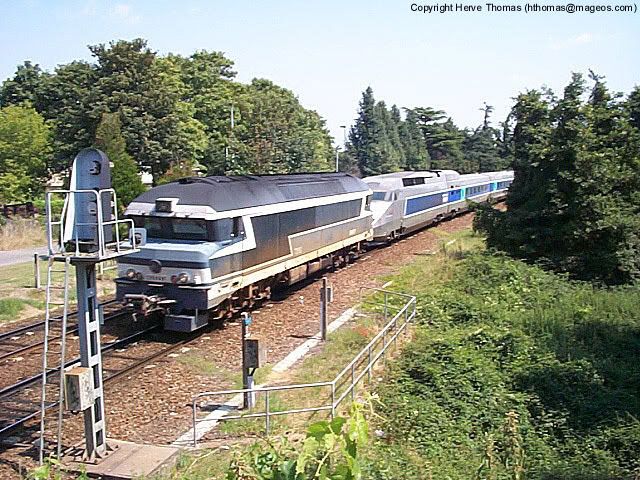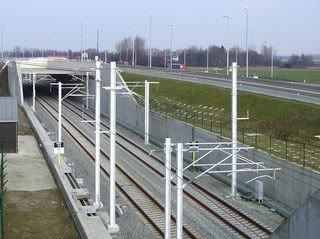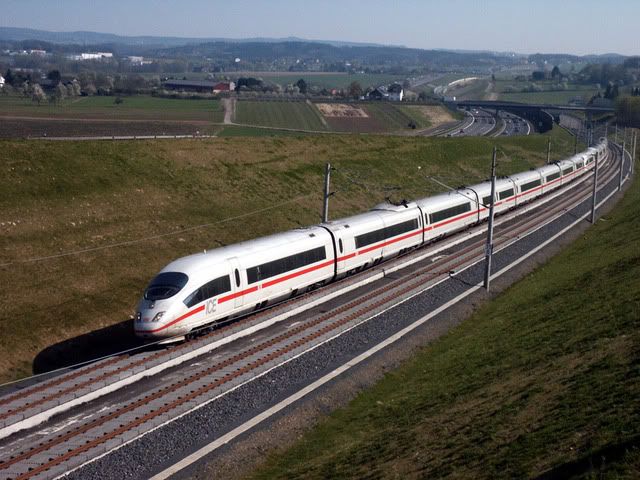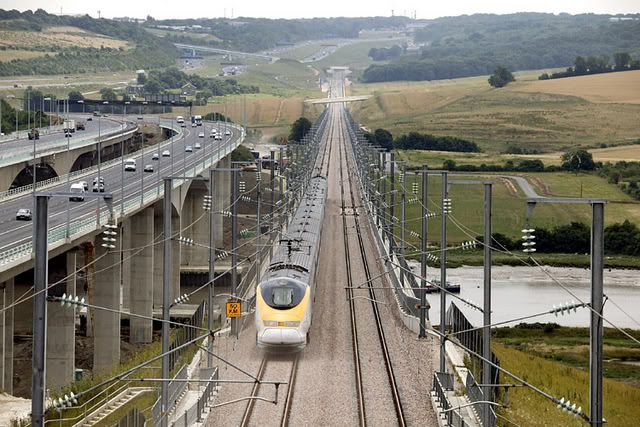I return to 2007 for "America was made for HSR" (Agent Orange links retained as the other blog I was posting to at the time is no longer up)
Wow, what a ride. Sometimes on Thursday ...
Thursday 22 March 2009, that is ...
... it felt like the America was made for High Speed Rail diary was going 200 mph itself. And I kept the ride going, cross posting the diary on the Euro and Booman Tribunes. And based partly on comments here and partly on comments there, kept polishing up the map.
Like the first diary, this is only a sketch, and 200mph routes are not the be-all and end-all of passenger rail, and this isn't a silver bullet ... but damn if it isn't one silver BB that is cool as all hell.
Now, I'm going to say the lessons follow below the fold in no particular order, so that if you see an order, I can call it serendipity, and if you don't see any order ... I told you so. ...
... (and anyway, any excuse to use the word serendipity is a good excuse, it's such a lovely word ... and you'd never believe how I stumbled across it ... but that, dear readers, is another story) ...
... with some additional reflections from late 2009.
Lesson One: Give the Silver BB image. Rinse. Repeat.
I am not sure I used the the Silver BB explanation enough times, early enough or often enough. I don't know whether I coined the phrase or stole it from someone else, but its become community property, used by farmerchuck, alizard, and A Siegel, ... among others, and hopefully more to come.
When people promise a "silver bullet" solution to solve all your problems (e.g., kill the werewolf that is troubling your village) and bake you the celebration cake too, it never works out as promised. Sometimes it does something useful, but its never a silver bullet ... indeed, some of the things that we are suffering from now, like gasoline powered motorcars spreading pollution, global warming, and suburban sprawl like an inexorable plague, were the silver bullets of an earlier day.
So the idea is to find the silver BB's ... the actual, if partial, solutions to a part of a part of the problem ... pack as many into a shotgun shell as can fit, and blast away. Repeat as necessary.
High Speed Rail is a silver BB. It has been proven to work at what it does, but what it does is only a part of a part of the solution. It can get some people out of some plane trips, and after that a smaller share of car trips, and after that a little air freight, and after that it can at times be used to assist with a very few road freight tasks.
And my diary was only about one small issue involved in one silver BB (but its such a shiny silver BB that lots of people wanted to talk about it, so they forced the discussion out of the confines of that tiny little issue).
So to everyone who pointed out that this does not solve Express land freight, or local commuter travel, or cross country air travel ... yes, and yes, and yes. But for getting people out of that plane that takes off from Columbus International Airport to O'Hare in Chicago, which reaches cruising altitude, cruises ten minutes, then starts its descent ... it can do that.
Aye-yup. At the time the silver BB's of walkable Transit-Oriented Development and the Nation of Bikeways strategy for cycling on the public right of way was already in view. Since then, the Silver-BB's of the Steel Interstate, regional stopping trains, Rapid Streetcars, trolley buses have also been added - and that is just the dimension of sustainable transport. Sustainable energy production, sustainable agriculture, and sustainable shelter are also each necessary and also each insufficient on their own.
Lesson Two: Use Old Numbers and People Will Call You On It
This all started out as a back of the envelope kind of exercise that spilled out of control. My cut-off for cities to look at was 1m ... that came from a rule of thumb circulating on the European Tribune. And I used 2000 Census Urbanized Area numbers. While these are not the SMA numbers that people are used to, it is also true that many of the cities near the edge will have grown over 1m mark in the 7 years since the census.
For the (very tiny) issue raised in the diary, it doesn't matter. The issue was, if criteria are set out, and HSR is allowed to grow project by project based on local enthusiasm and local market conditions, would the result look anything like a network created under a Master Map? Because, if we get a reasonably good Map from a bottom-up approach, then we can avoid the political fight over what the map should look like, and focus on getting reasonable criteria put into place.
In the new map above, the dashed red lines between the Northeast and Southeast networks show part of what happens if precisely three cities tip over the 1m mark ... Memphis and Nashville, in the traditional urbanized area sense, and Charlotte NC as a "networked" city based on (currently ongoing) investment in local rail knitting the broader area together. There's also dashed lines for Jacksonville. Don't fret if you reckon that there are more ... it could easily take thirty years for the system to be built out, and by that time a number of cities will come into the frame.
I have yet to see any dramatic proof in any of the dramatic top-down maps offered that they offer something dramatically better than setting more or less reasonable criteria and getting started.
And this leads straight into lesson three ...
Lesson Three: What Is High Speed?
We Americans are awfully insular people. I should have said seven times that what we call "High Speed" in the US is simply not high speed. 100mph is not HSR. We were going 100mph in 1930. European and Japanese HSR had reached 150+ mph by the 1960's, and have since built routes and trains that allow effective trip speeds of 200mph ... for conventional High Speed Rail. This is not "maglev", but steel wheels on steel tracks.
Now, 100mph is a really good idea, for both passengers and freight. I would love to see a 100mph network from one side of the country to another (noth to south and east to west). I would love to see 100mph lines from New York and Boston to Albany, then through the upstate cities to Buffalo, then to Cleveland, Akron, Canton, Newark, Columbus, Dayton, Cincinatti, Louisville and on ... and Cleveland, Toledo, Detroit, west across Michigan and to Chicago. And multiply that nationwide.
In trying to find a term that allows me to convey a feeling of pretty darn quick without making America look silly and backward in Europe, I've settled on "Express" for that "1930's era HSR" kind of pace.
And bear in mind that the French are not shy about taking their TGV off the high speed corridor onto the regular train network (though not running at 150mph or 220mph). The Paris-Bordeaux service is high-speed less than half-way, from Paris to Tours. So if the high speed corridor bypasses a smaller city, that does not mean that all the services bypass that city. Some will come out of the corridor on a local Express rail network, pick up passengers, and return to the corridor further along.
Indeed, this French service has a terminus in a resort area where they do not allow overhead electric wires for the TGV, so its being towed by a diesel locomotive:
So I probably should have stressed that HSR corridors are the trunks for HSR services, but the services are not limited to the corridors. In particular, the HSR will have a station at a major hub airport if it passes in the vicinity ... and the remaining HSR stations will be selected from the three to five most important interchange stations between local commuter/shopping rail systems and interurban Express passenger rail system ... whether those systems are in place or still on the drawing board.
And then Senator Obama won the Presidency, and made Roy LaHood his Secretary of Transportation, and the entire fuzzy mess was clarified with their three tier system - true "Express HSR"; the 125mph tier of "Regional HSR", slower than Express HSR but faster than road transport; and the 110mph tier of "Emerging HSR", time-competitive with road transport, at roughly half the cost of Regional HSR and a fifth of the cost of Express HSR.
I argued at the time and still think that this is very politically adroit. It is, indeed, much of the political foundation for the present situation where the White House submits a budget figure for HSR and the political fight is whether to raise that by 20% or to quadruple it.
Indeed, I wish the administration could have been that adroit on most things - getting the argument to be on whether to be a little bit better than the White House proposed or a lot better would be a welcome sight in either the Health Insurance Reform or Climate Bill debates.
Lesson Four: Running Next to Highways
A lot of people raised the question of where we are going to get the Right of Way for these corridors ... and a lot of people suggested using Interstate Highway right of way. When I took this to the European Tribune, I discovered that the Europeans are way ahead of us here (and I owe a special thanks to DoDo at the European Tribune):
This is in the Netherlands:
This is on a Belgian/German line:
This is in Italy:
This is in France:
This is on the Channel Tunnel Rail Link, and actually answers the question, "what do you do when the expressway is too bendy for HSR?" ... "You use the non-bendy parts and provide a straighter line corridor for the bendy bits":
So, yes, it would appear that one option is to build the HSR corridor into the fringe of selected Interstate Highways. And to answer the question as it is tickling up through some of your clever brains ... yes, all of these systems have automatic sensors to detect a car falling onto the line, in addition to their structural features designed to make that as unlikely as possible.
This is still a critical lesson. Indeed, after the 110mph Midwest and Ohio Hubs have been upgraded to 125mph, when it comes time to provide an Express HSR corridor between the greater New York area and the Great Lakes, a corridor generally along the I-80 alignment through New Jersey and Pennsylvania may bear a closer look
Lesson 5: The Core Corridors
On the European Tribune, I was asked to compute the geometric mean of population for mile for the various two-city pairs, to get an idea of where things would probably get started first. So I did. The geometric mean is the two populations multiplied together, then take the square root. The reason for using it instead of the simple average is that it adjusts for the fact that a pair of 3m:3m cities will have a bigger interurban travel market than a pair of 5m:1m cities.
And that is partly encoded in the map above. There was a substantial break between 16,000 and 18,000, so all the trips from 16,000 up (the biggest is New York / Boston at 39,000 average per mile) are shown in in the widest lines, and the ones 16,000-10,000 in the next wider lines.
The core lines (those over 16,000 in bold) are ... on the East Coast:
* 39,508 New York / Boston
* 33,476 New York / Philadelphia
* 31,627 New York / Baltimore
* 27,073 New York / Providence
* 20,978 New York / Washington
* 14,335 Orlando / Tampa
* 13,777 Washington / Virginia Beach
* 12,506 Washington / Pittsburgh
* 10,901 Miami / Orlando
In the Great Lakes / Midwest:
* 21,625 Chicago / Detroit
* 18,013 Chicago / Indianapolis
* 12,625 New York / Cleveland
* 11,828 Indianapolis / Cincinatti
* 11,114 Chicago / Cleveland
* 10,333 Chicago / Minneapolis (via Milwaukee)
In ... well, let's just call it Texas:
* 15,923 Dallas / Houston
* 11,140 Houston / San Antonio
On the West Coast:
* 37,435 Los Angeles / San Diego (via Riverside)
* 14,717 Los Angeles / Phoenix (via Riverside)
* 14,285 Los Angeles / Las Vegas (via Riverside)
* 12,687 Seattle / Portland
Now, in terms of population-miles served per dollar, the Express rail system is going to give the most "bang for the buck" in a lot of the United States. However, some areas could justify HSR right now, if the funding was available ... and, the more we build out an Express Rail network, the easier it will become to justify a HSR project, because of the opportunity to run HSR trains out of the HSR corridor into the Express passenger rail network.
Remember, this is just one silver BB ... but it sure is a shiny one.
If anything, I would amplify this. A single Express HSR corridor from New York City through northwestern NJ and northern PA, northern Ohio and northern Indiana to Chicago, combined with junctions to corridors already planned for 110mph systems (which, recall, can be upgraded to electrified, 125mph corridors in a series of incremental upgrades) means:
- NYC / Chicago via lots of country in the middle of nowhere, and
- NYC / Cleveland / Toledo /Detroit, junctioning with the 125mph corridor in NW PA;
- NYC / Pittsburgh, junctioning with the 125mph corridor in NW PA;
- NYC / Columbus / Dayton / Cincinnati, junctioning with the 125mph Triple-C corridor in northern OH;
- Chicago / Cleveland / Buffalo, junctioning with the 125mph Triple-C corridor in northern OH;
- Chicago / Detroit / Toronto, junctioning with the Columbus/Detroit corridor in NW OH
- Chicago / Columbus, junctioning with the Columbus/Detroit corridor in NW OH
- Chicago / Pittsburgh, junctioning with the 125mph Triple-C corridor in northern OH;
... and of course with the northern sections of the hypothetical "Appalachian Hub" proposal, the rang of destinations expands further.
So while I argue it is essential to think through what trips it makes sense to provide with Express HSR, given the populations and distances and other factors that drive transport markets ... it continues to be a mistake to think of Express HSR corridors in isolation from the next tier down.
All Done ... well, not all done learning lessons, but these are five that I wanted to write up ... a lot of others are still percolating in my head.
... and I can only underline that - I have only just begun to learn!
Midnight Oil: Forgotten Years
Still it aches like tetanus / It reeks of politics
Signatures stained with tears
Who can remember, we've got to remember
The hardest years, the darkest years / Forsaking aching breaking years
The time 'n' tested heartbreak years
These should not be forgotten years
The blinded years, the binded years / The desperate and divided years
These should not be forgotten years
Remember










2 comments:
This has been and continues to be a wonderful series.
Here's someone, maybe you are aware of them, who is doing the same thing you do but with BRT, Bus Rapid Transit.
I love generalist, non-purists.
http://www.humantransit.org/
Làm sao để tìm dịch vụ van chuyen hang di Da Nang hoặc nơi nhận chuyển hàng đi Hà Nội. Vậy thì hãy liên hệ với Proship chúng tôi. Với các dịch vụ đang cung cấp hiện nay của chúng tôi như dịch vụ ship hàng tại hà nội, cho thuê kho bãi, cho thuê đất trống, chuyển phát nhanh trong nước, ship hàng nội thành tphcm, dịch vụ ký gửi hàng hóa, dịch vụ bốc xếp, cho thuê kho quận 10. Đảm bảo khi đến với chúng tôi bạn sẽ hài lòng vì chúng tôi có tất cả các dịch vụ vận chuyển lưu trữ mà bạn đang cần.
Post a Comment